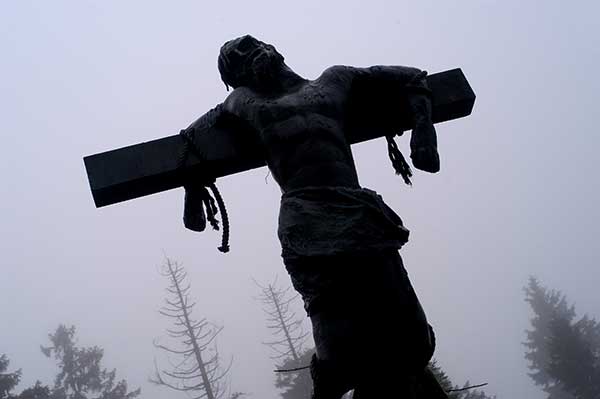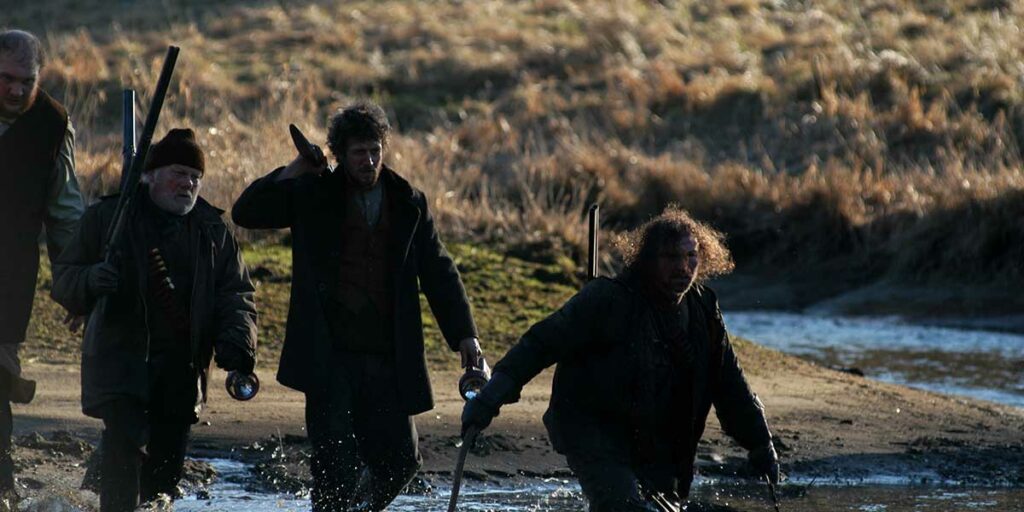Calvaire is so beautifully shot that it is difficult to look away even in its most horrific scenes, but the movie could’ve used more emotion in its storytelling.
Both the original titles, Calvaire, and the English version, The Ordeal, offer a pretty good idea of what the movie is about from different perspectives. Calvaire suggests the presence of the profane and the martyr of innocence. On the other hand, The Ordeal in its most literal meaning calls back to a prolonged experience of suffering and pain, however, it also evokes the ritualistic tradition of divine proof of innocence from ancient times. The title is the first hint at the movie’s intention to dissect the profane through powerful symbolism, a bold move at the peak of a cinematic movement known as French New Extremity.
The French New Extremity was essentially the matching point of psychological horror and exploitative horror in the 2000s, addressing the limits of human sanity in the face of harrowing traumas taken to the most horrific extremes. Movies from the French New Extremity were famous for their intellectual approach in stories filled with disturbing graphic violence, and as someone who loves movies such as Martyrs and Trouble Every Day but held quite divisive thoughts about titles such as Irreversible and La vie nouvelle, for example, I wasn’t entirely sure how invested I would be in Calvaire. I was surprised to see that most of the film’s violent content is reserved for the viewer’s own subconscious rather than graphic onscreen violence.
Calvaire’s premise is quite straightforward, although the film takes its time to build up the feeling that something is off, and I found myself questioning throughout the film’s whole first hour what kind of threat we would have here. Marc (Laurent Lucas) is a minor singer and performer traveling across France from bit to bit until his car suddenly breaks down on an inhospitable road, where a thick white fog seems to be his only companion. Marc eventually stumbles upon a peculiar stranger (Jean-Luc Couchard) looking for his dog, and is led by him to an empty inn managed by Mr. Bartel (Jackie Berroyer), a suspicious man who will do anything to prevent Marc from leaving.
The movie sets off quite awkwardly after one of Marc’s performances at a retirement home, where an old lady and a nurse make unwanted romantic advances upon him. This seemingly meaningless scene turns out to be a clear sign of Marc’s position in the narrative; a dangerous object of desire who unfolds a pertinent discussion on sin vs. temptation, given that Marc isn’t to blame for the effect he has on others. Things started to get messy once I realized Calvaire’s opening scene was the only and last time I would see a woman in the movie, and how the film’s main message revolved entirely around their absence.

There’s something about Calvaire’s silent, foggy landscapes that is deeply unsettling, and the brutal inhospitality of the village where Marc’s car breaks down is responsible for the tension that emanates from the film’s first hour. Then the movie finally turns into pure nightmare fuel when Mr. Bartel, Marc’s innkeeper, snaps, offering the twist that sets up Calvaire’s main conflict: convinced that Marc is in fact a projection of his long-gone wife Gloria, also a performer, Mr. Bartel decides to keep his host captive and force him to personify the woman he lost. An abrupt narrative shift like that feels nearly laughable in theory but is addressed with such brutal indifference in the movie that I was effectively taken off guard and immediately drawn by Calvaire’s messed-up portrayal of what a society ruled by barbaric male instincts would look like.
After all, it appeared to me that the last bit of civilization in Mr. Bartel’s little village was gone along with the female figure of Gloria. Calvaire dives head down into straight-up absurdity, unveiling a distorted version of Eden where Adam, the serpent, and the apple are the sole characters. The movie takes advantage of the French New Extremity’s most distinctive trademarks, that is, the soul-crushing violence fueled by psychological horror, to look back into the trajectory of the horror genre as a whole. Above else, Calvaire discusses the banalization of violence against women in horror, and how it became one of the pillars of the genre, especially with the rise of exploitation. In this context, the movie recounts the story of Gloria and her tragic demise by putting a man in her place, defying the historically violent approach towards women in the horror genre.
It’s no coincidence that the French New Extremity’s most popular movies are represented by female characters in unspeakable pain: in Inside, a woman about to give birth is haunted by a strange visitor who wants to take away her baby. In Martyrs, two best friends are subjected to extreme acts of torture in an attempt to have a glance at the afterlife. This represents the French New Extremity’s consistent attempts to get rid of the shackles of decades of genre conventions, and Calvaire is equally bold for portraying the banalization of violence against women felt in the skin by a man, Marc.
However, as much as the film hits the nail on the head with its heavy subtext, the overall experience is hauntingly impersonal, for better or for worse. The antagonists in the movie are merely echoes of what they’ve been, repeating the same vicious acts that took away their humanity, meaning what we see in Calvaire are merely empty shells devoid of emotions. It’s then up to Marc, the only genuine humane character in theory, to bring a certain personality to the narrative, but the script doesn’t seem to decide whether Marc should be merely a witness or an independent person. The movie desperately wants us to witness humanity slipping away from Marc as he descends into madness, but such humanity is never explored in-depth. The film’s reckless character development leads to an anticlimactic conclusion, and Calvaire suffers from being a horror movie where not a single death scene is slightly impactful.
In sum, the movie stands out as an atmospheric piece with important things to say, but it always feels like an allegory rather than something authentic. For this reason, the instances of graphic violence cause some discomfort but are never really impactful. Aside from its heavy message, Calvaire’s biggest standout is how dreadfully beautiful to look at the movie is. The presence of a vibrant red that escalates with the film’s climax is deeply unsettling, and by the end, made me feel as if I was actually witnessing what hell on Earth would look like. The bloody aspect of the night in contrast with the angelical white of the morning is something only Benoît Debie could’ve pulled off, a cinematographer known for his nauseating imagery in many of Gaspar Noe’s movies. The lack of an immersive score works in Calvaire’s favor as it only intensifies the power of its chilling visuals, which have only aged better in a welcoming 4K restoration.
Calvaire will be released on digital platforms in the UK from 19 September, 2023. In the US, the film is now available to watch on digital and on demand.

